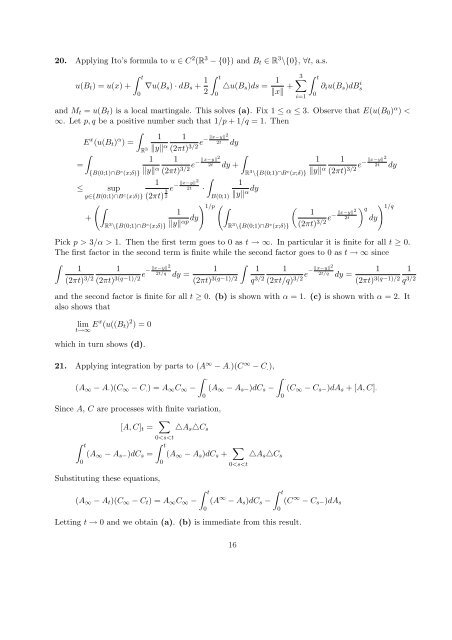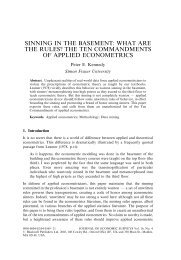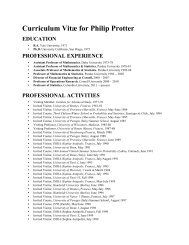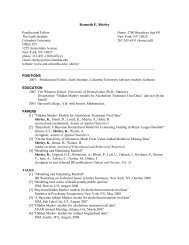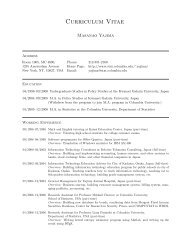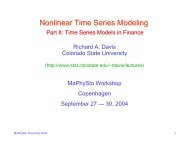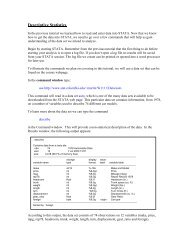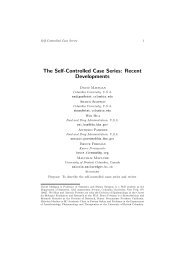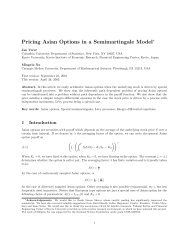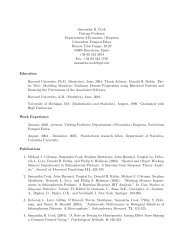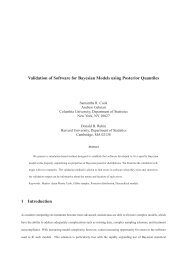Solution to selected problems.
Solution to selected problems.
Solution to selected problems.
Create successful ePaper yourself
Turn your PDF publications into a flip-book with our unique Google optimized e-Paper software.
20. Applying I<strong>to</strong>’s formula <strong>to</strong> u ∈ C 2 (R 3 − {0}) and B t ∈ R 3 \{0}, ∀t, a.s.<br />
u(B t ) = u(x) +<br />
∫ t<br />
0<br />
∇u(B s ) · dB s + 1 2<br />
∫ t<br />
0<br />
△u(B s )ds = 1<br />
‖x‖ + 3∑<br />
i=1<br />
∫ t<br />
0<br />
∂ i u(B s )dB i s<br />
and M t = u(B t ) is a local martingale. This solves (a). Fix 1 ≤ α ≤ 3. Observe that E(u(B 0 ) α ) <<br />
∞. Let p, q be a positive number such that 1/p + 1/q = 1. Then<br />
∫<br />
E x (u(B t ) α 1 1<br />
‖x−y‖2<br />
) =<br />
R 3 ‖y‖ α e− 2t dy<br />
(2πt) 3/2<br />
∫<br />
∫<br />
1 1<br />
‖x−y‖2<br />
1 1<br />
‖x−y‖2<br />
=<br />
{B(0;1)∩B c (x;δ)} ‖y‖ α e− 2t dy +<br />
(2πt) 3/2<br />
R 3 \{B(0;1)∩B c (x;δ)} ‖y‖ α e− 2t dy<br />
(2πt) 3/2<br />
∫<br />
≤<br />
sup<br />
y∈{B(0;1)∩B c (x;δ)}<br />
+<br />
1<br />
(2πt) 3 2<br />
( ∫<br />
R 3 \{B(0;1)∩B c (x;δ)}<br />
e − ‖x−y‖2<br />
2t ·<br />
B(0;1)<br />
1<br />
‖y‖ α dy<br />
1<br />
‖y‖ αp dy ) 1/p ( ∫<br />
R 3 \{B(0;1)∩B c (x;δ)}<br />
(<br />
1<br />
‖x−y‖2<br />
e− 2t<br />
(2πt) 3/2<br />
) q<br />
dy) 1/q<br />
Pick p > 3/α > 1. Then the first term goes <strong>to</strong> 0 as t → ∞. In particular it is finite for all t ≥ 0.<br />
The first fac<strong>to</strong>r in the second term is finite while the second fac<strong>to</strong>r goes <strong>to</strong> 0 as t → ∞ since<br />
∫<br />
1 1<br />
(2πt) 3/2 (2πt)<br />
3(q−1)/2<br />
e−<br />
‖x−y‖2<br />
2t/q<br />
dy =<br />
∫<br />
1<br />
(2πt) 3(q−1)/2<br />
1 1<br />
‖x−y‖2<br />
q 3/2 e− 2t/q<br />
dy =<br />
(2πt/q) 3/2<br />
1 1<br />
(2πt) 3(q−1)/2 q 3/2<br />
and the second fac<strong>to</strong>r is finite for all t ≥ 0. (b) is shown with α = 1. (c) is shown with α = 2. It<br />
also shows that<br />
lim<br />
t→∞ Ex (u((B t ) 2 ) = 0<br />
which in turn shows (d).<br />
21. Applying integration by parts <strong>to</strong> (A ∞ − A·)(C ∞ − C . ),<br />
(A ∞ − A·)(C ∞ − C . ) = A ∞ C ∞ −<br />
∫ ·<br />
Since A, C are processes with finite variation,<br />
[A, C] t = ∑<br />
△A s △C s<br />
∫ t<br />
0<br />
(A ∞ − A s− )dC s =<br />
Substituting these equations,<br />
0


